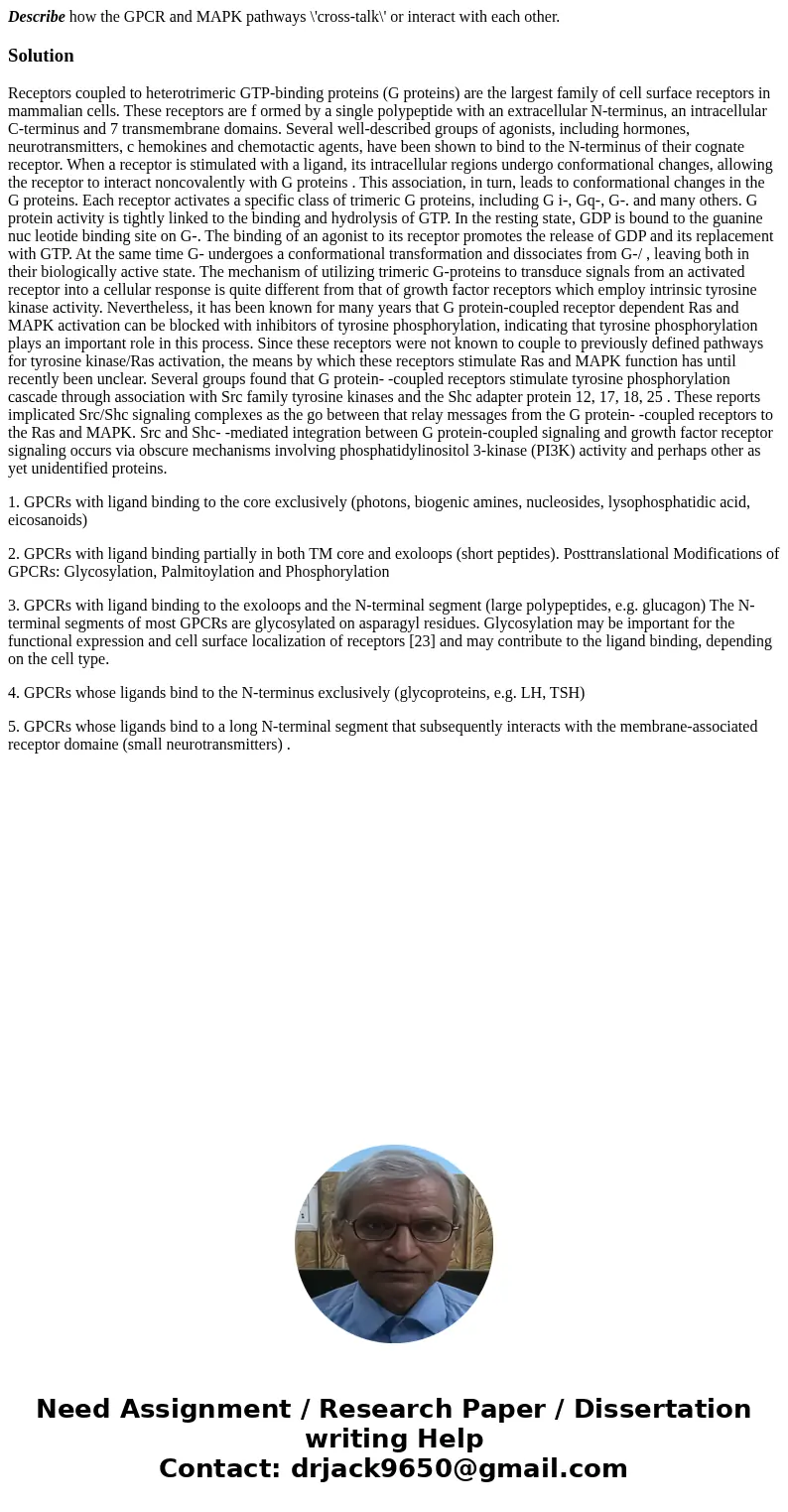Describe how the GPCR and MAPK pathways crosstalk or interac
Describe how the GPCR and MAPK pathways \'cross-talk\' or interact with each other.
Solution
Receptors coupled to heterotrimeric GTP-binding proteins (G proteins) are the largest family of cell surface receptors in mammalian cells. These receptors are f ormed by a single polypeptide with an extracellular N-terminus, an intracellular C-terminus and 7 transmembrane domains. Several well-described groups of agonists, including hormones, neurotransmitters, c hemokines and chemotactic agents, have been shown to bind to the N-terminus of their cognate receptor. When a receptor is stimulated with a ligand, its intracellular regions undergo conformational changes, allowing the receptor to interact noncovalently with G proteins . This association, in turn, leads to conformational changes in the G proteins. Each receptor activates a specific class of trimeric G proteins, including G i-, Gq-, G-. and many others. G protein activity is tightly linked to the binding and hydrolysis of GTP. In the resting state, GDP is bound to the guanine nuc leotide binding site on G-. The binding of an agonist to its receptor promotes the release of GDP and its replacement with GTP. At the same time G- undergoes a conformational transformation and dissociates from G-/ , leaving both in their biologically active state. The mechanism of utilizing trimeric G-proteins to transduce signals from an activated receptor into a cellular response is quite different from that of growth factor receptors which employ intrinsic tyrosine kinase activity. Nevertheless, it has been known for many years that G protein-coupled receptor dependent Ras and MAPK activation can be blocked with inhibitors of tyrosine phosphorylation, indicating that tyrosine phosphorylation plays an important role in this process. Since these receptors were not known to couple to previously defined pathways for tyrosine kinase/Ras activation, the means by which these receptors stimulate Ras and MAPK function has until recently been unclear. Several groups found that G protein- -coupled receptors stimulate tyrosine phosphorylation cascade through association with Src family tyrosine kinases and the Shc adapter protein 12, 17, 18, 25 . These reports implicated Src/Shc signaling complexes as the go between that relay messages from the G protein- -coupled receptors to the Ras and MAPK. Src and Shc- -mediated integration between G protein-coupled signaling and growth factor receptor signaling occurs via obscure mechanisms involving phosphatidylinositol 3-kinase (PI3K) activity and perhaps other as yet unidentified proteins.
1. GPCRs with ligand binding to the core exclusively (photons, biogenic amines, nucleosides, lysophosphatidic acid, eicosanoids)
2. GPCRs with ligand binding partially in both TM core and exoloops (short peptides). Posttranslational Modifications of GPCRs: Glycosylation, Palmitoylation and Phosphorylation
3. GPCRs with ligand binding to the exoloops and the N-terminal segment (large polypeptides, e.g. glucagon) The N-terminal segments of most GPCRs are glycosylated on asparagyl residues. Glycosylation may be important for the functional expression and cell surface localization of receptors [23] and may contribute to the ligand binding, depending on the cell type.
4. GPCRs whose ligands bind to the N-terminus exclusively (glycoproteins, e.g. LH, TSH)
5. GPCRs whose ligands bind to a long N-terminal segment that subsequently interacts with the membrane-associated receptor domaine (small neurotransmitters) .

 Homework Sourse
Homework Sourse